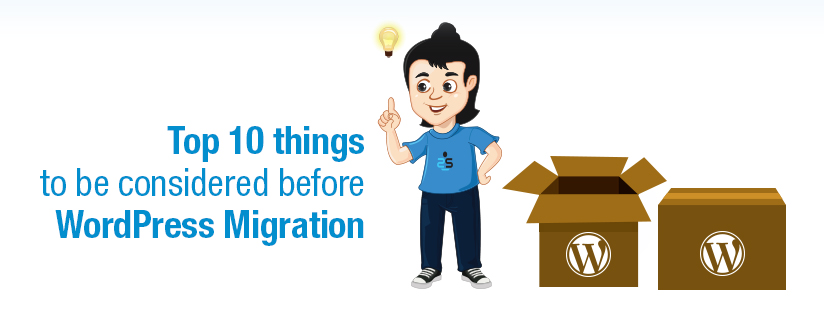Published on: April 14, 2018 by Angela Philip

Scenario:
Doing WordPress migration can look like a big task if it’s your first time and if you haven’t done it properly, it will cause several problems. So, it is important to give a little caution while doing WordPress migration.
Before migrating a WordPress site there are many things that are to be considered. The most 10 important things are:
All the above perform an important role in WordPress migration. For the best performance of our site, we have to check each one in detail.
To check the features of source and destination host is the first and most important step to be considered before the migration of a website. Always choose the reliable destination host for the migration. The chances of conflict will be very low if you select a host with the same features as that of the source. These features include Operating System, control panel etc.
Before migrating a WordPress site you have to take the backup of the files from the old account. For that, we have to determine the size of the files and directories. If the size of the files is larger in size then it will be difficult to download the files directly to the system. Because this may cause storage problems. So to avoid that we could use the command line to take the backup of files. You have to be aware of the size of the files before taking the backup. The backup of the files is stored in the tar format inside the system.
In order to take the backup of the database, you have to check the size of it. If the size is affordable by the system then you can choose the export option in phpmyadmin. Or else you can choose the command line as the better option. You can create a dumb SQL file which is stored in .sql format.
One of the important steps is to check if the control panels of the source and destination servers are same or not. If they are same then it will be easy for a panel to panel transfer compared to the one with different control panels. The chances of getting an error are high if the control panels are not same. So try to pick up the host with the same control panel as that of the source.
Moving the domain without changing the home as well as site URLs is simple. It can be done by just moving the files. If the database and URLs are same you can move by just copying the files and databases. If the database name changes then you have to edit the wp_config.php file. And if the URL changes then you have to change the home URL and site URL of the database from wp_options from phpmyadmin option. When your domain name changes then there will be additional concerns. Even if the files and database are moved there will be some references to the old domain which will remain in the database and can cause an error. So you should be careful when changing the URLs.
Plugins have equal importance in WordPress migration. So we need to consider the plugins before migrating the WordPress site. The plugins that are used at the source may not be compatible with the destination server so that it will create a conflict during migration.
In such cases, you have to reinstall the plugins so as to avoid the conflict.
Before the migration, we have to check if the server that hosted the database is a local host or not. We can import the database only after considering that. One thing to be noted is that it should be same as source and destination host.
There will be some changes in the php versions of both the source and destination servers. We have to check it before starting the migration.
A website will work normally only when the php version is same as that of the source. If it is not then we have to set the php version same as that of the source. The standard php version used is 5.6.
Sometimes the website that is working fine on the source server will not be working properly on the destination server. So to avoid such cases you to check the compatibility of the site on the destination server.
For the proper working of the website, you have to check if the modules we activated at the destination server or not. If not you have to activate then do it before the migration. Else it will cause some errors to the website after the migration. So always be careful with modules on the destination server.
There are many ways to do WordPress migration and the popular way is using plugins. But there are many drawbacks to using plugins for WordPress migration. Also, it is very important to prevent loss of traffic during WordPress migration.So we always prefer you to do WordPress migration yourself or with the help of experts.
Category : WordPress

Add new commentSIGN IN